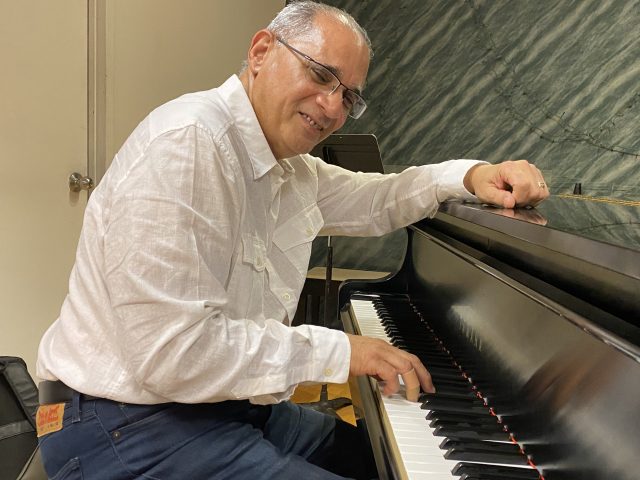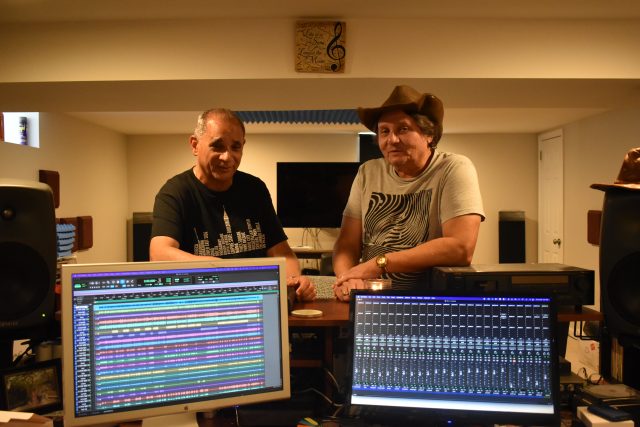Allegro
Hector LeGuillow: breathing new life into salsa
Member profile
Volume 123, No. 9October, 2023

Native New Yorker Hector Leguillow was born in the tumultuous year 1953. The Baton-Rouge bus boycott had just laid the pathway for the civil rights movement proper. Charlie Parker and Dizzy Gillespie’s immortal “Jazz at Massey Hall” was in every record store, yet Patti Page’s “Doggie in the Window” held onto its number one slot on the charts. Hemingway won the Pulitzer for “The Old Man and the Sea,” and James Baldwin’s “Go Tell It on the Mountain” and William Burroughs’ “Junkie” were notably published. Lucille Ball gave birth to Desi Arnaz Jr simultaneous to the “I Love Lucy” birth of Little Ricky. Arthur Miller’s “The Crucible” was on Broadway, McCarthy was raging on, the Korean War came to a crushing close, and the Rosenbergs were executed. Quite the backdrop for a young artist-to-be.
“When I was very young, we lived in Spanish Harlem,” Hector LeGuillow reminisced, “and then the family moved to the South Bronx.” The area was wrought with music which bore an immediate influence on him. “I was listening to Ray Barretto, big bands, small bands, Puerto Rican traditional music and a lot of mambos and cha-chas. It was simpler then. Later the music included jazz chords, but I learned it all by listening.”
Of course, like other budding musicians, the draw was also in the scene around the sounds. “As a young teenager, I saw a pianist playing at a club. The music was great but what caught my eye were the two girls hanging out —I thought: this is a good thing!” So, at 15, Hector’s mother bought him a small Magnus electric organ by hosting Stanley product parties in their living room. This coincided with the rise of salsa music, especially within the Bronx neighborhood of Throgs Neck, where the family next relocated to. “I’m a self-taught musician,” he explained, “I focused on piano and also experimented with hand drums and saxophone. But I was always making plans for the next step,” he recalled enthusiastically.
1971 saw Hector’s high school graduation and the founding of his Orchestra Flair, a 10-piece band with trumpet, tenor saxophone, trombone, three percussionists, piano, bass, and vocals. (“We wore pink shirts with pink ties)!”. Orchestra Flair won second place in a band contest and was hired by the school for a boat ride from Bronx to the Catskills. Among the band’s popular repertoire was Tito Puente’s “Oye Como Va,” already a huge hit by Santana.
The band started regular gigs in Harlem clubs as well as playing weddings, and within a year, Orchestra Flair was hired by the prestigious Riverside Plaza Hotel to open for popular attraction the Tito Rodriguez Orchestra. Even with this modicum of success, always striving, LeGuillow reimagined the band, angling toward a wider array of venues in the Bronx and Manhattan. Now dubbed the Chosen Ones (La Escojiva), the leader’s goals only expanded further. In 1976, he attended City College where his music teacher was Charlie Palmieri, brother of the renowned Latin music leader Eddie. He also studied Drama (“it was always my other love”), and then the following year, attended Baruch College’s Business School. But it wasn’t too button-down. “I hosted a radio show, Latin Voyage, on Baruch’s station. My record collection of 6000 included every Latin genre and jazz, with a lot of Return to Forever. Chick Corea was one of my mentors.” Spinning also became a part-time job when Hector was hired to DJ at the Roses Lounge, alternately performing with noted vocalist Orlando Aviles’ ensemble. LeGuillow reshaped the Aviles band’s sound, adding top area musicians Arthur Webb, a jazz flutist, and Felix Vega Jr (trumpet). The line-up came to include two violins (one is standard), “and the addition of the trumpet was special; Vega and Webb played so well together. We played the Copa, the Village Gate, Chateau Madrid, BAM, all of the colleges as well as the Kool Jazz Festival.”
The band also recorded with the celebrated engineer David Rodriguez (Kip Hanrahan, Reuben Blades). “We met back in 1980 and now he mixed and mastered my new album,” Hector added. However, in 1987 the band broke up. “The music began changing: Romantic salsa became the new thing”. In the interim, LeGuillow founded the short-lived Blue Chip records and his own booking agency, largely catering to the growth in house music at Roseland and the downtown clubs in addition to those well beyond New York City.
“But I wanted to play my own music again,” he recalled. Flamingo Paradise was Hector’s next ensemble, one that has since grown into the MTG All-Stars. “But it’s so hard for an independent musician to make a living. So, I began acting, taking background roles whenever I could and worked a part-time job at Bloomingdales, at the Chanel counter,” where he met Angela Bassett who was very encouraging and led him in the right direction. “A month later I got called for ‘New York Undercover.’ I wasn’t in SAG-AFTRA yet, but I looked like an actor who’d just quit the show and they needed a replacement… to play a priest. The role began small.” Ironically, the day LeGuillow was laid off at Bloomingdales, the episode was shown. Within months, he began working in many small roles on “Law and Order,” “Sex and the City,” “Oz,” and others. And then in 1999 he began a steady core background role on “Law and Order: SVU,” having his own desk within the precinct SVU office.
Even within this period of TV and film growth, LeGuillow returned to the recording studio to work on some of the music he’d begun years earlier. His immersion into both worlds, however, peaked in 2005 when called on as a music consultant for the major motion picture El Cantante, starring Jennifer Lopez and Marc Anthony. This biopic of the late salsa superstar Hector Lavoe incorporated music as a staple and LeGuillow became central to the production. “I had met Lavoe in the 1970s and saw him regularly over the years. He encouraged me to change my name to “La Llave” (the key). His name wasn’t really “Lavoe” (the voice); it was the record company that changed it!,” he said.
Though still engaged in acting work, LeGuillow became inspired to focus on music. In 2013 his MTG All-Stars, here expanded to include a riveting string section, recorded an album of Hector Lavoe’s music, “Viva El Cantante,” with the leader billed, appropriately, as Hector “La Llave” LeGuillow.
Continuing, always, his vision for advancement, LeGuillow became a member of Local 802 and can often be found playing piano in the city’s venues. Further, a new album, “The Key Project,” set for a 2024 release, pairs him again with legendary engineer David Rodriguez. Anticipating the new release, Hector LeGuillow is already booked for a tour which will carry him, most prominently, into Montreal and other parts of Canada, before moving on to Europe. “I have dedicated my life to salsa and my mission is to make sure this historical and cultural music does not fade away. It’s been a long ride getting here, but I am looking forward to 2024,” the pianist added.
John Pietaro, Local 802’s director of organizing, is a published writer and poet.

Hector Leguillow with engineer/producer David Rodriguez
